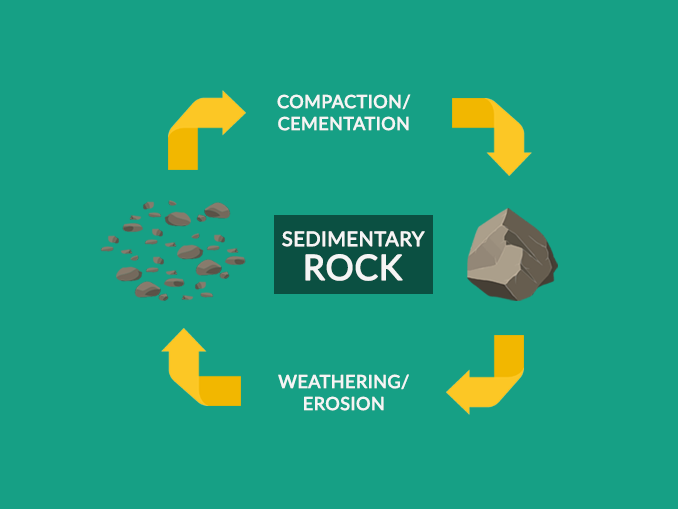Describe the Processes Used to Make Sedimentary Rocks
Four basic processes are involved in the formation of a clastic sedimentary rock. Sedimentary rocks are formed by the deposition and subsequent cementation on the material at the Earths surface within the bodies of water.

How Do Sedimentary Rocks Form Earth How
It forms by the settling of particles from either water or air the word sediment comes from the Latin sedimentum meaning settled.

. Describe a specific example of a sedimentary rock becoming an igneous rock. Sedimentary igneous and metamorphic. Which of the following processes forms biochemical sedimentary rock.
Compaction - sediment is squeezed and crushed until it. By deposition of sediment particles from air water or ice environments clastic or detrital rocks or. Over time the sediments are compacted and cemented to form rocks.
Process by which particles settle out of transport medium C. Compaction and cementation of loose particles to form solid rock D. Into a sedimentary rock.
How are Sedimentary Rocks formed. Sediments derived primarily by biogenic processes biological and biochemical include carbonates limestones and dolostones peat coal and other accumulations of organic matter such as oil shale and phosphates. Sedimentary rocks are formed by the lithification of inorganic andor organic sediments or as chemical precipitates.
To summarize sedimentary rocks are rocks that form as the result of four major processes. Eventually the sand is deposited on the ocean floor and builds up over long periods of time. Sedimentary rocks like sandstone shale and limestone differ from other rocks in that they.
By precipitation of minerals from solution in water nonclastic or chemical rocks. Sedimentary Rocks the result of deposition of fragments of rocks. Each of these rocks are formed by physical changessuch as melting cooling eroding compacting or deformingthat are part of the rock cycle.
Of these stages erosion is the Choose one. Sedimentary rocks can be classified according to how they form. Accumulation and the consolidation of sediments.
Weathering erosioncaused mainly by friction of waves transportation where the sediment is carried along by a. Layer boundaries are natural planes of weakness along which the rocks can break and. Nonfoliated rocks can also form by metamorphism which happens when magma comes in contact with the surrounding rock.
Are grains of sediment cemented together by various minerals. The process of sedimentation takes millions of years at the least. Formation of a clastic sedimentary rock involves five stages.
Sediment in the ocean is mostly sand which floats around as small particles. Evaporation of seawater D. The most important geological processes that lead to the creation of sedimentary rocks are erosion weathering dissolution precipitation and lithification.
Deposition of weathered remains of other rocks. Wind water ice and gravity erode and deposit these sediments. Four basic processes are involved in the formation of a clastic sedimentary rock.
Are formed from layers of sediment built up over many years. The main contributors to sedimentary rock formation are erosion precipitation or natural weathering. Sand is eroded from rock deposited on the ocean floor and after millions of years of heat and pressure forms rock again.
Sedimentary rocks like bituminous coal limestone and sandstone given enough heat and pressure can turn into nonfoliated metamorphic rocks like anthracite coal marble and quartzite. Erosion and weathering include the effects of wind and rain which slowly break down large rocks into smaller ones. This can be accomplished through some combination of compaction and cementation.
Sedimentary rocks are formed from pieces of other existing rock or organic material. Compaction is the packing together of grains reducing the pore space between them and can be caused by burial beneath more sediment. Coral molluscs but unlike multicycle.
Metamorphic Rocks formed out of existing rocks undergoing recrystallisation. Sketch this diagram on your answer sheet. Cementing together of shell fragments.
Lithification is the term used to describe any process that turns sediments into sedimentary rock. Weathering erosioncaused mainly by friction of waves transportation where the sediment is carried along by a current deposition and compaction where the sediment is squashed together to form a rock of this kind. During lithification sediments compact View the full answer.
Making sediment into rock lithification -. As well as lithification and dissolution. May contain fossils - remains of plants and animals that were caught up in the sediment.
Rock Cycle Site 1. There are three main types of rocks. 1 The process of converting sediment in to a sedimentary rock is known as lithification.
Deposition of quartz sand on a beach C. These environmental phenomena slowly eat away at dirt or rock surfaces or wash sediments together which eventually build up into rock formations. Which can then be applied to much older sedimentary rock sequences.
These deposits may also contain fragmental debris such as bioclastic fragments in limestones eg. Deposition of the results of biogenic activity. Weathering produces particles called sediments.
Clastic and Chemical Clastic sedimentary rocks form when existing parent rock material is weathered fragmented transported and deposited in layers that compact. Use your own words to describe the sequence of processes that result in igneous rocks. Disintegration of bedrock into separate particles.
Horizontal layering in sedimentary rocks is called bedding or stratification. These rocks are formed in four ways. Separation of rock or regolith from its substrate B.
There are two types of sedimentary rocks. Go back to step 2 and put the name of each process illustrated in the animation on the appropriate arrow. Accumulation of mud on the seafloor B.

The Process Of Sedimentary Rock Formation This Step In The

Sedimentary Rocks And Processes

Sedimentary Rock Formation Activity Sedimentary Rock Formation Sedimentary Rocks Sedimentary
Comments
Post a Comment